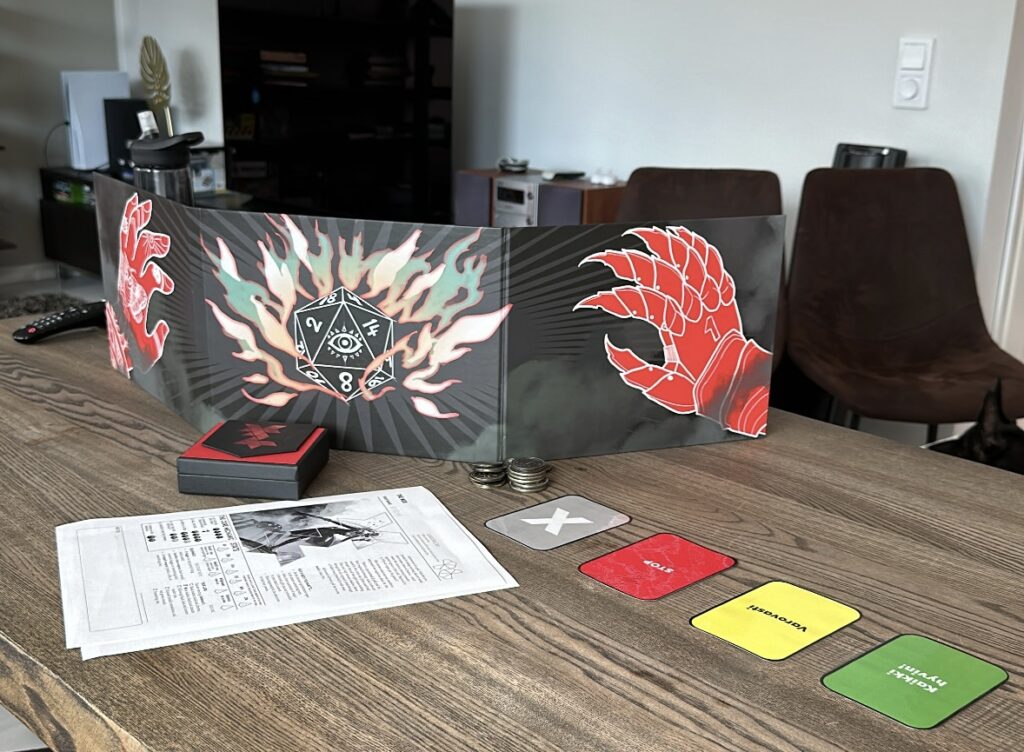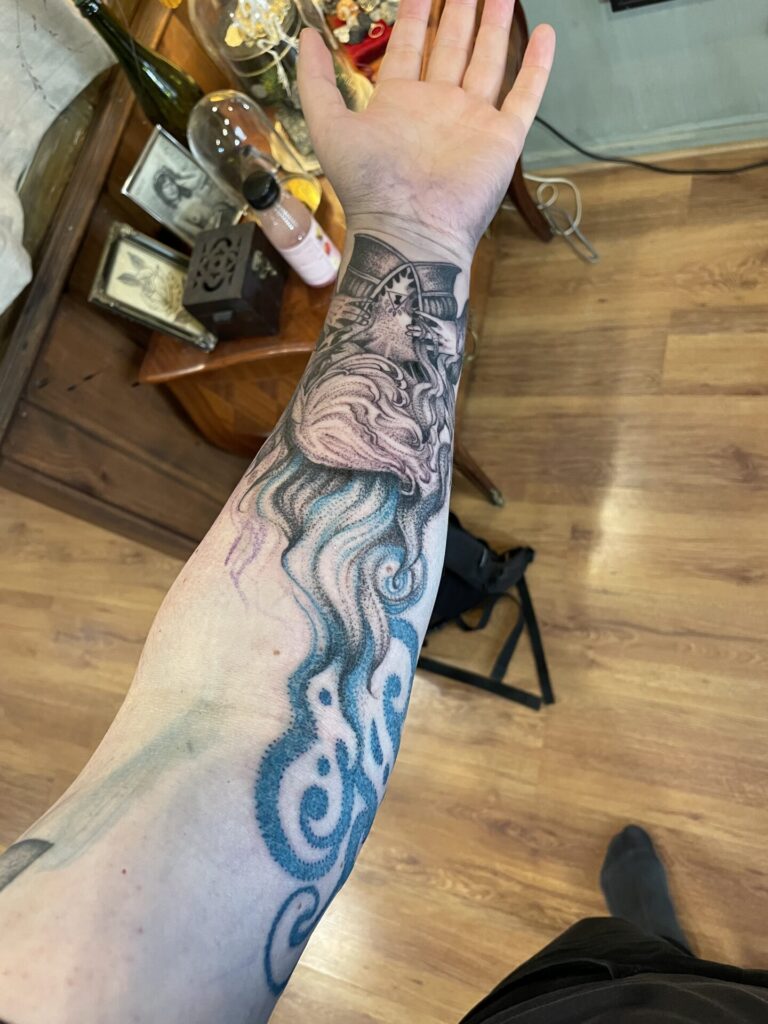We played the Bizarre Love Triangles: An Ex-Crawl from the DIE RPG scenario book of the same name. These are notes on how the prewritten scenario format worked, what we liked, and where we struggled. Spoilers on the adventure follow.

DIE as a game
DIE is a very meta roleplaying game. Players create ordinary, emotionally messed up characters (Personas), who then sit down at a table to create fantasy roleplaying game characters (Paragons). When this play within play starts, the Personas end up physically inside the game world, as the Paragons. The players are thus playing a character, playing a character, in a game within a game. It can get very whimsical, and also very, very dark. The game’s content is pulled from the real-world struggles, regrets, doubts, and conflicts of the Personas, and these are likely to reflect real players’ issues in the real-real world. It has a lot of weight. Or it can be very dumb fun.
The game is based on a comic book with the same name, and was actually created simultaneously with the comic, by the same writer/designer, Kieron Gillen, working with the same artist, Stephanie Hans, and designer, Rian Hughes. Someone could say it’s a symbiotic relationship, while I would categorize it as parasitic. I love the comic book dearly.
The game is inspired by a lot of things, and can’t really draw a direct line of lineage to anything specific. It revolves around a simple D6 dice pool mechanic, but each character (Paragon) has their own special rules that break and modify the basic rules. Conflict resolution is very quick. The characters are very powerful, but also break easily.
The meta pervasiveness continues to everything in the mechanics, and I love the game for it. I’d argue the game is better if you’ve read and played a lot of different roleplaying games. It will work without that just fine, but you’ll get a big kick out of all the meta commentary going on.

Bizarre Love Triangles, the scenario book
The way DIE works is by building a group of messed up characters. The GM will probe them for a lot of detailed stuff in their messy backgrounds, and then use all of that material to populate the game world with. You keep running into echoes of your Persona’s life (locations, people, events) from outside the game. Because of this, it’s next to impossible to really prepare for the game in advance. You need to react to what the Personas end up becoming.
How do you write a pre-written scenario for this kind of game? The first scenario book (a second scenario book has been confirmed) shows you how: by writing the character generation anew, and pre-writing easily malleable scenes to which pre-selected character generation answers will then provide the details for. So instead of being “some people”, you are a specific, thematic group of people, and the scenario replaces the default character generation questions with a new set, driving home that theme, and building up to the encounters in the scenario.
The book has three such scenarios. One is about fighting ex lovers, set all over the realm, traversing a map as you do. Another one is about troubled teens at a summer camp. The last one is about the drama of (once) high level collectible card game players (bring your own cards).
Bizarre Love Triangles: An Ex-Crawl, the scenario
I have to say that the subtitle An Ex-Crawl is what sold this to me. I love a hexcrawl scenario, common in old school fantasy games. The scenario is set on a map – the exploded D20 familiar from the comic book and game cover.
The scenario has a couple of unconventional premises. First off, none of the Personas might be familiar with roleplaying games. Second, the Master isn’t really around. They’re taken in the first scene, and when they’re encountered again, they’re in no shape to really do anything. Usually in DIE the Master is an active actor who can push things when needed – here a lot more is riding on the other Personas. Third, the game uses the exploded D20… but it doesn’t assume it works like it does as a physical object, ie. it’s not really a projection of a sphere, but rather a flat design.

How it went down
I had three players, out of an original planned five. I don’t know how this would’ve worked with five. DIE characters need a lot of air, and I feel we just about managed with the three – with five either we couldn’t go as deep, or some players would be left in the sidelines, or we would’ve taken a lot more time. Probably all of that, and that would’ve lead into a potentially cumbersome, potentially not great experience.
We played for three sessions, as planned. If I were to use all of the content in the scenario, I would’ve needed at least four, more likely five sessions. My players? They beelined towards the captured Master and the exit, skipping all of the optional content. Now, there’s a moment in the scenario where a gate, guarded by an army, requires the Paragons to turn back to get more experience, guiding them to their bespoke advancement scenes. Some of them read like they’re a lot of fun! My Ecstasy Knight? They had just realized that they can defeat “an army” using Creative Violence, and they did just that, bypassing about half of the content in one blaze of shocking violence.
I was quite concerned in advance about how chaotic and disjointed things might feel. In the default DIE setup, the characters share a fantasy world, so there’s an agreed baseline to things. Not so here. We went from one heavy echo to the next, sometimes stumbling on direct scenes from the Personas’ normal lives, sometimes putting more fantastic/horror trappings on them. I warned the players in advance that this might be more of a “music video” fantasy than a “Lord of the Rings” fantasy, secretly hoping that’s the direction the players would take it. So they did. The game’s strong (entirely imagined, theatre of the mind) visuals came up as a high point in the post game debrief.
We opened with the Fallen cherubs attacking amidst the burning car wreckage, as designed, and this set the scene beautifully. I strongly advise always coloring your Fallen to really deliver on your game’s theme. Then when the Paragons moved on, the first thing they encountered was a beach house from one of the Persona’s lives, turned into a quasi medieval inn, filled with echoes of people important to them. I made sure there were some strong direct callbacks for all Personas here, and that gave everyone an idea of what to expect. (The roof of the inn was another bar, from a videogame one of the Personas played, filled with characters from that game, and the first NPCs they encountered were friends of the third Paragon, given a fantasy makeover.)
An example of how out there this got was a climax scene set in a castle shaped like a trophy on its side, on top of a Gothic moor, all decaying graveyards and withering rose gardens. Inside the castle was a massive hall with a garage with electric guitars on one side, a bedroom on the other, a living room at the far end, and in the middle of it, the underside of the Eiffel tower, with an outdoors restaurant. Into this waded a Paragon decked out as a sexy bishop, wielding a giant hammer, who ultimately set the entire place on fire. One player said “this is out of a Beyonce production”, and I smiled.
All of this worked because it was fully based on what the players told me about the Personas in the beginning, down to the details. You don’t need a whole lot of these, but make sure you use them for full effect.
The other thing I want to highlight is setting expectations: players need to understand what they’re getting into. I repeated the trick of asking a player (Persona) something specific, and then they would immediately encounter just that thing in the game. Extreme example was asking a Persona how many casual one night stands they could remember They said “eighteen”, and eighteen exes came out of the woods for blood. (I had them give a single line description of each as they were disposed of.)
After the second game we had a lot of material for the bizarre love triangle between the Paragons/Personas, a good idea about their exes, and lacking motivation for rescuing the Master, because I had neglected the Master. (They are taken away in the initial scene set in Die, and don’t really have any impact on the proceedings later.) I considered rewriting the third game’s finale to just work with the material we already had, but decided to follow the prewritten scenario to the end, after all. I found a way to incorporate everything I had on the table from the Personas into the court of exes (area 16), but had to force the players to go there – there was an impenetrable wind pushing them in that direction, which is about as railroady as I’ve ever got. I do feel that dropping the prewritten path and just going with the material organically built at the table would’ve worked better. But it might’ve taken us longer than a session to go through.
We struggled with giving enough character specific hooks. I had to rush towards the end to make sure we end on time, and that left both the Ecstasy Knight and the Neo without a lot of opportunities to play with their toys. They did get to do something class specific, often in pivotal ways, but not to the full extent of their powers. The Godbinder had an easier time with getting their toys out. This is something to keep in mind in the future, but bear in mind that this takes time at the table.
A mechanical detail: the Emotion Knight felt conflicted about the Emotion Scale. Using it drops it to zero, and building it up can take a long time, leading to the Knight’s player conserving the power instead of using it. I get why that might be good – the Emotion Knight can be the nuclear option for the party – but I would argue towards letting quite minor things move the scale up to level 3 to make it feel like something they can play with, instead of hoarding it.

Conclusion
DIE is a great game. I don’t expect it works for everyone, but some players get a real hard kick out of it. The meta layers are something else, stuff you just don’t see in other games. Maybe you have to be a hopeless geek to really value it, but hey, it really works for us, in the same way I feel Die the comic book was written for me personally.
I had doubts about non-core-D&D-fantasy premises as setups for DIE the game, but this ex-crawl centered on just the love lives of the Personas worked beautifully. It’s a surprisingly flexible setup for generating nightmares at the table.
Leave a Reply